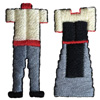 Caps, coifs, and bonnets were a must for European women since around the 10th century and up to the mid-20th century. The variety of sizes, shapes, materials, and adornments is so impressive that modern glamorous fashion designers would envy the artisans’ imagination. Although, floral prints, cute ruffles, embroidered designs, and fancy laces are among the favored decorations for all times. For example, here are a few lovely examples of Swedish headwear pieces from The American Swedish Institute that date back to the 19th – early 20th century.
Caps, coifs, and bonnets were a must for European women since around the 10th century and up to the mid-20th century. The variety of sizes, shapes, materials, and adornments is so impressive that modern glamorous fashion designers would envy the artisans’ imagination. Although, floral prints, cute ruffles, embroidered designs, and fancy laces are among the favored decorations for all times. For example, here are a few lovely examples of Swedish headwear pieces from The American Swedish Institute that date back to the 19th – early 20th century.
The photos are from The American Swedish Institute
Traditional Swedish bonnet made from cream-colored wool, with traditional print of red & pink flowers, dark green leaves, and blue berry-like buds. The headdress is tied under the chin by thin red strings

Fitted bonnet with a folk floral print. It has piping around the face edge with red tape. This headpiece is from around 1922-1932


Swedish cap called “bindmössa”, 1950-1960. It is a lovely tiny rose cap adorned with stylized floral embroidery


Child's folk bonnet decorated with pretty traditional floral print. It's piped in red and has darker red ribbon strings


Traditional Swedish folk cap called “bindmössa” from 1925-1930. It is covered in navy blue silk satin and has a large decorative bow at the back. Net lace with white embroidery is added to frame the face – such a chick lady’s item of wardrobe

Fitted bonnet from 1922-1932, with fuchsia panel from brow to nape with sides of traditional rose & stem pattern print. Wide lace pleated border around face with narrow fuchsia piping looks wonderful




